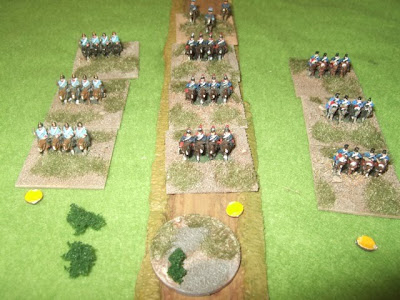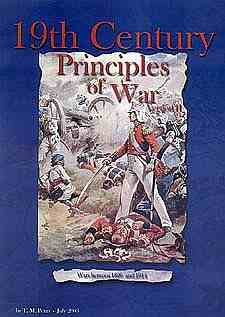







 The model is built of foamcore and plastic card on a hardboard base. The brickwork on the end wall above is from one of those bases that come with the old Matchbox (now Revell) tank kits.
The model is built of foamcore and plastic card on a hardboard base. The brickwork on the end wall above is from one of those bases that come with the old Matchbox (now Revell) tank kits. The windows, door etc are from a Wills pack of building accessories - very handy for this kind of job.
The windows, door etc are from a Wills pack of building accessories - very handy for this kind of job.

After a slow period I got in a couple of hours’ painting on Saturday and got the first of the recent flea market purchases painted. It’s the Humakti Adventurer from the old Citadel miniatures Runequest Adventurers boxed set.
Before and after pics below:


I’ve had some Irregular Miniatures Franco-Prussian War figures for years and have considered a number of options for using them. For a while I was quite keen on developing my own DBA-derived set of rules. I called them “Dans Un Pot De Chambre” after General Ducrot’s comment at finding the army surrounded by the Prussians at Sedan, “Nous sommes dans un pot de chamber et nous y serons emmerdé” (We’re in a chamber pot and we’re going to get shat upon).
The Irregular Miniatures rule-box for the period was toyed with as was an adaptation of Peter Pig’s Square Bashing. Neither really grabbed me.
I then tried Les Gens Braves and They Died For Glory. At the time I wanted one strip of Irregular Miniatures to represent a battalion so I could do the big battles of the war rather than smaller actions. With either of these rules you’d need positively megalomaniacal numbers of figures to do a major action. Is it me or is this typical of American-published rule sets?
I also looked at Volley and Bayonet. Much closer to the right scale – elements are brigades – but I didn’t like to see big, square bases teetering on the edges of hills.
In the end I settled on Principles Of War as a final option. It doesn’t really do the big battle thing but I’d reached the point were I just wanted something that would get me using the figures. If POW didn’t prove to be the rules for me then the figures were going on eBay!
So what’s POW like? Well, at the heart of it is a fairly conventional set of rules. Each battalion-sized unit has a strength (which may be variable or fixed) and loses strength points as it takes casualties. There’s a DBA-like initiative point system for movement within a brigade (extra movement if you’re not close to the enemy) and morale is handled by rolling under current strength on 1d20.
Where the rules do score as innovative is in the command and control system above brigade level. An army might consist of four brigades each of which is represented in the early part of the game by a Movement Base. An army gets one or more extra “dummy” movement bases depending on the overall commander’s quality. This allows the player to disguise the main focus of his attack.
Movement Bases (and subsequently deployed brigades once the base has been “spotted” by the enemy) follow an arrow that the player has drawn on his map of the battlefield. A command marker advances along the line of this arrow and the elements of the Brigade are penalised if they don’t stay within a fixed radius of this marker. Strangely this marker isn’t the General’s own element – the general flits around rallying pinned units and saying “follow me lads”.
In general I’m happy with POW so far. If I have a problem at all it’s the familiar one that many rules writers struggle to communicate their ideas to a player attempting to pick up the rules by reading them rather than being guided by an experienced player.
It takes long enough to learn a new set of rules. If you aren’t being taught them by someone who already knows them, then you should at least be spared the trouble of trying to puzzle out unnecessarily ambiguous wording. One of the sections of POW says something like “A unit may make only one move and/or formation change per turn”. That careless “and/or” renders the intent of the sentence utterly opaque. Is a change of formation a type of move? It could mean “one move or change of formation” or perhaps “one move and one change of formation”.
I asked on the POW mailing list and was assured that the latter is the case. A dragoon regiment, in our case was faced by enemy infantry it was unable to engage because they were in terrain impassable to cavalry. It may, it seems, given the initiative points and suitable flexibility in its orders, make a about-face (a formation change) and withdraw (a move) within a single game turn.
Far better then for the rules to have said, “A unit may make a maximum of one move and one formation change per turn”. No significant increase in space used but a significant increase in clarity.
I know Phil Barker’s use of legalistic language doesn’t receive universal approval, but at least it’s generally unambiguous.

Will McNally has very kindly sent me a list of the units mentioned in Charles Grant’s The War Game. It’s the finest, artisan-made nostalgia and it's reproduced here for your enjoyment:
Grand Duchy of Lorraine
INFANTRY
Soissonaise
Picardy
Normandy
Auvergne
Champagne
Piedmont
Royal Vaisseaux
Rohan Soubise
Dauphin
Royal la Marine
Grenadiers de France
Grenadiers du Roi
Genadiers de Penthievre
Navarre
Royal Corse
Royal Ecossais
Dillon
Bulkeley
Garde Française
Garde de Lorraine (1st Grenadier Battalion)
Garde de Lorraine (2nd Battalion)
Garde de Lorraine (3rd Battalion)
MILITIA
Legion de Luneville
Legion des Ardennes
Legion de la Camargue
Legion de Nord
Legion de Flandres
Legion D’Alsace
LIGHT INFANTRY
Volontaires Contabres
Chasseurs de Monet
Fusiliers de Lorraine
Fusiliers de la Morliere
Arquebussiers de Grassin
LIGHT CAVALRY
Chasseurs de Fischer
Lanciers de Saxe
Hussards Volontaires de St Victor
HEAVY CAVALRY
Gendarmerie du Roi
Les Mousquetaires
Allemand
Cuirassiers du Roi
Commissaire-General
Grenadiers a Cheval
Bourbon
Mestres de Camp General Dragoons
ARTILLERY
Metz Battery
La Fere Battery
Genoble Battery
Besanscon Battery
Lorraine Howitzer Battery
Corps Royal du Genie (1st Battalion)
Corps Royal du Genie (2st Battalion)
Barge Crew and Xebek Crew
Vereinigte Freie Städte
INFANTRY
Löwenstein-Oels Grenadiers
Ostergotland Infantry
Preobrazenski Grenadiers
Leib Garde Grenadiers
Schotse Grenadiere Van Lauder
Pfalz Sonderheim Infantry
Sobieski Infantry
Raczinski Infantry
Fynske Infantry
Oldenburg Infantry
Putzenkammer Grenadiers
Butyrsky Infantry
Kronprinz Grenadiers
Knyphausen Grenadiers
Livegarden Infantry
Schaumburg Lippe Infantry
Pfaffenhofen Infantry
Vastmanland Infantry
Ismailovski Grenadiers
Grenadier Garde Der Sammlung (1st Bn)
Grenadier Garde Der Sammiung (2nd Bn)
Grenadier Garde Der Sammiung (3rd Bn)
LIGHT INFANTRY
Freiwilliges Jager Korps
Radetski Jagerkorps
Feldjagerkorps
Jägerkorps zu Fuss
MILITIA
Schlavonische Grenze Bn
Karlstadt Grenze Bn
Croatische Grenze Bn
Warasdiner Grenze Bn
Pandour Grenze Bn
Banater Grenze Bn
LIGHT CAVALRY
Von Ratzmer Ulanen
Bosniak Ulanen Korps
Von Ruesch Hussars
Freikorps Ulanen
HEAVY CAVALRY
Kronstadt Dragoons
Leib Garde zu Pferde
Rijkswacht te Paard
WolfenbUttel Küirassiere
Kleistchen Frei Dragoner
Ahlefeldt Küirassiere
Hohenzollern Kurassiere
Gardes du Korps
ARTILLERY
Hoistenke Battery
Skarsborg Battery
Luneburg Battery
Lubumirski Battery
Falkenstein Fortress Battery
Langensalza Fortress Battery
Kronbourg Pioneer Battalion
Konigsmarck Pioneer Battalion 3 wagons
Barge and Xebec Crews